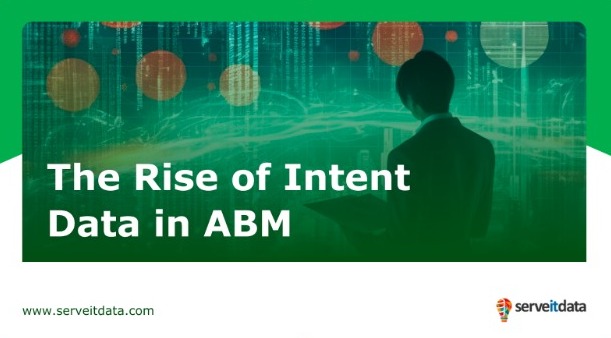The Rise of Intent Data in ABM: How to Harness Real-time Insights for Targeted Engagement
In the fast-paced world of B2B marketing, having a deep understanding of your target accounts’ needs, interests, and intent is crucial for driving successful engagement and conversions. This is where intent data comes into play. Intent data provides real-time insights into the online behaviour of potential buyers, allowing marketers to identify accounts that are actively researching and exhibiting buying signals. In the realm of Account-Based Marketing (ABM), harnessing intent data has become increasingly essential for delivering targeted and personalized experiences to the right accounts at the right time.
So, what exactly is intent data? Intent data is the behavioral information collected from various sources, such as website visits, content consumption, social media interactions, and search activities. It provides valuable insights into the topics, products, or services that potential buyers are actively researching or showing interest in. By analyzing intent data, marketers can gain visibility into the purchase intent of specific accounts and tailor their marketing efforts accordingly.
One of the primary benefits of intent data in ABM is its ability to identify accounts that are in the market for a particular solution or service. This allows marketers to prioritize their efforts and allocate resources to those accounts with higher purchase intent. By focusing on accounts that are actively researching relevant topics, marketers can engage with them at the right time, with the most relevant messaging and content.
To harness the power of intent data for targeted engagement in ABM, here are some key steps to consider:
Identify and prioritize target accounts:
Start by defining your ideal customer profile (ICP) and identifying the key accounts you want to engage with. Look for intent signals that align with your ICP criteria, such as visits to relevant product pages, engagement with industry-specific content, or intent keywords in search queries.
Leverage technology and data providers:
Intent data platforms and data providers can help you gather and analyze intent data effectively. These platforms use sophisticated algorithms and machine learning to identify and score intent signals, providing you with actionable insights for your ABM efforts.
Align sales and marketing efforts:
Intent data is most powerful when sales and marketing teams collaborate closely. Share the insights and data with your sales team to help them prioritize their outreach and have more meaningful conversations with target accounts.
Personalize messaging and content:
Use intent data to create personalized messaging and content that resonates with the specific needs and interests of the accounts you are targeting. Tailor your campaigns and outreach based on the intent signals you have gathered.
Monitor and adjust in real-time:
Intent data is dynamic, and buying signals can change quickly. Continuously monitor and analyze the intent data to ensure you are staying aligned with the evolving needs and interests of your target accounts. Make adjustments to your campaigns and strategies accordingly.
Measure and optimize:
As with any marketing effort, it’s crucial to measure the impact of your intent data-driven ABM campaigns. Track metrics such as engagement rates, conversions, and revenue generated to assess the effectiveness of your strategies. Use the insights gained to optimize and refine your future campaigns.
In conclusion, the rise of intent data in ABM has transformed the way B2B marketers engage with target accounts. By leveraging real-time insights into the online behavior and buying intent of potential buyers, marketers can deliver highly targeted and personalized experiences that drive meaningful engagement and conversions. By following the steps outlined above and staying attuned to the evolving needs of your target accounts, you can harness the power of intent data to fuel the success of your ABM initiatives.


